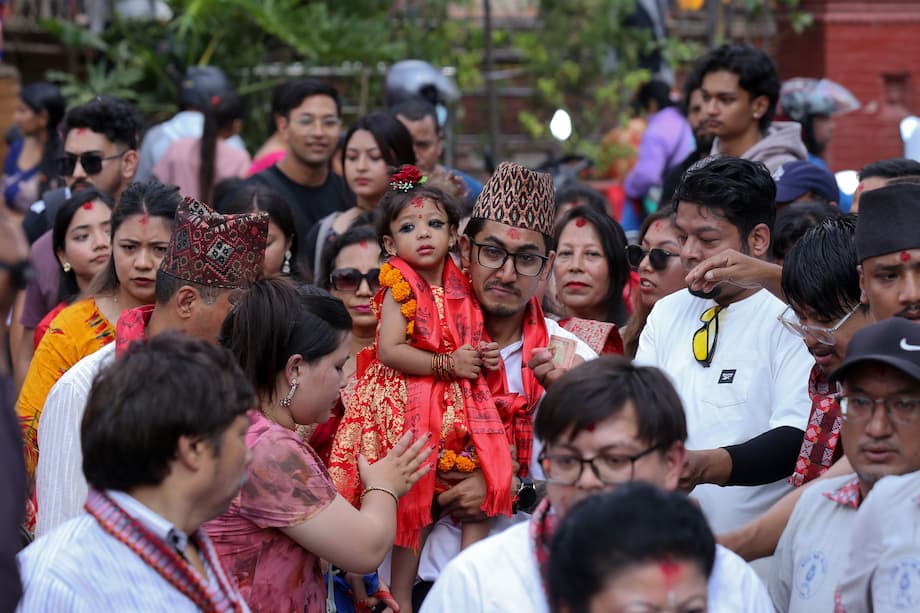Inside Kathmandu, a child ascends to living goddess
On a packed festival day in Kathmandu, a toddler from the Newar community was lifted above the crowds and carried to an ornate brick palace. At 2 years and 8 months, Aryatara Shakya has been chosen to become Nepal’s new living goddess, the Kumari. The city paused on the eighth day of Dashain, the country’s 15 day celebration of the triumph of good over evil, as family members, caretakers and priests brought her to Kumari Ghar, the temple palace that will be her home for years.
- Inside Kathmandu, a child ascends to living goddess
- What is the Kumari tradition
- How a Kumari is chosen
- Life inside the Kumari Ghar
- The festivals that bring the goddess to the streets
- Voices from the family and community
- Tradition meets modern rights and reforms
- After the throne, the return to ordinary life
- Cultural meaning in a changing Nepal
- At a Glance
She replaces 11 year old Trishna Shakya, who served since 2017 and stepped down after reaching puberty, the point at which tradition holds that divinity departs. Along the route to Durbar Square, friends and devotees lined the lanes to touch their foreheads to the child’s feet, the highest sign of respect in Hindu custom. Dressed in red with her hair gathered into a topknot and a painted third eye on her forehead, the new Kumari received applause and offerings as she entered her residence.
In the coming days, she will deliver public blessings, including to Nepal’s president, and appear on set dates during major festivals. The rest of the time she will live mostly in seclusion, a revered child whose presence is sought by both Hindus and Buddhists. Her selection has renewed global curiosity about a tradition that is central to the heritage of the Kathmandu Valley and also the subject of careful reform in modern Nepal.
What is the Kumari tradition
In the Kathmandu Valley, Newar families have long honored a prepubescent girl as the manifestation of divine female energy, often called Shakti. The girl is believed to host the presence of Taleju, a form of the protective goddess Durga. The living goddess is called Kumari, a word from Sanskrit that means princess and often used to mean virgin in Nepali.
The best known of several living goddesses is the Royal Kumari of Kathmandu, who resides at Kumari Ghar near the old royal palace. Sister traditions exist in Patan and Bhaktapur, and in other historic towns of the valley. The institution crystallized under the Malla dynasty in the 17th century, although the ritual veneration of girls as embodiments of divinity is far older in South Asia. The Kumari stands as a bridge between Buddhism and Hinduism, a Buddhist child from the Shakya clan who is revered as a Hindu goddess.
How a Kumari is chosen
Choosing a Kumari is an exacting process overseen by priests and caretakers in consultation with Newar elders. Families from the Shakya community present eligible daughters, usually between ages two and four, for consideration. Clean health, serenity, and auspicious astrological signs matter, along with the absence of scars or marks that could bleed and end the tenure.
The search and the 32 qualities
Traditional texts describe 32 attributes of perfection that selectors look for. The descriptions are poetic, not clinical. They include eyes like a deer, a chest like a lion, eyelashes like a cow, and a voice that is clear and gentle. Inspectors examine teeth and nails, and they look for a calm, observant demeanor. The goal is not beauty in a modern sense, but a combination of physical wholeness and poise that reflects the ideal of purity.
Tests of fearlessness and astrology
The child must not be afraid of the dark. Older accounts describe trials in dim rooms with ritual masks, drums, and offerings meant to test composure. Horoscope readings are matched with the calendar and with the nation’s needs. Once selected, the child undergoes purification rites, then takes her seat in the throne room where she will grant audiences. A single rule guides her daily life, any form of bleeding, whether from a scraped knee, a lost tooth, or menstruation, signals that the goddess has departed and the tenure is over.
Life inside the Kumari Ghar
Inside Kumari Ghar, life follows a sacred routine. The child performs daily worship with the help of priests and caretakers. She greets visitors during set hours, seated on a carved wooden throne. During festivals she goes outside, carried in arms or in a palanquin, since touching the ground is avoided to preserve ritual purity. Her facial makeup and the painted third eye signal her role as a living seat of the goddess.
The city interprets her gestures as omens. A smile is read as good fortune, crying or laughter can be warnings, and gifts returned to devotees are taken with special care. The Kumari receives the respect once reserved for kings. Before the monarchy ended in 2008, the head of state sought her blessing each year as a sign of legitimate rule. That rite continues today with Nepal’s president.
The festivals that bring the goddess to the streets
Kathmandu’s public devotion to the Kumari reaches its height during Indra Jatra, a week of dances and masked processions that mark the end of the monsoon season. During the festival, a chariot bearing the Kumari is pulled through historic squares, and thousands gather to catch her gaze. The following Kumari Jatra specifically celebrates the living goddess, and her presence is taken as a sign of protection for the city.
Indra Jatra is closely followed by Dashain, the 15 day festival of victory and renewal observed across Nepal, and then Tihar, the festival of lights. On the eighth day of Dashain, when Aryatara Shakya took her seat, schools and offices closed as families gathered for rituals. These autumn observances knit together community life, and the Kumari’s blessing is considered a source of collective good luck.
Voices from the family and community
Aryatara’s father, Ananta Shakya, described a moment of astonishment and pride as his daughter’s new life began, and he shared the family belief that her destiny was foretold by a dream during pregnancy.
‘She was just my daughter yesterday, but today she is a goddess. My wife during pregnancy dreamed that she was a goddess, and we knew she was going to be someone very special.’
Priests who serve the Kumari stress that the role rests on faith and the sanctity of ritual. Udhav Man Karmacharya, a senior priest involved in Kumari rites, speaks of the need for secrecy around ceremonies inside the temple.
‘It is a mystery. It is sacred. If we tell all of the secrets, she will no longer be a goddess, but just a common woman.’
Tradition meets modern rights and reforms
The Kumari tradition has faced scrutiny from rights advocates concerned about education, mobility, and the isolation of children. A 2008 Supreme Court ruling affirmed that the institution should continue, and it also directed authorities to support the well being and schooling of the girls. In the years since, Kumaris have received private tutoring inside their palaces, and some have been able to attend classes with careful supervision.
Retired Kumaris now receive a state pension that families describe as modest, about 110 dollars per month. Caretakers say the stipends and tutoring make daily life more stable and help future reintegration. Televisions and computers are no longer taboo, and some young goddesses study languages and mathematics after their public duties.
After the throne, the return to ordinary life
Leaving the throne can be jarring. Former Kumaris often speak of the challenge of joining a classroom after years of limited contact with peers. Some say that walking freely in crowded lanes takes practice because they were carried for much of childhood. Domestic chores and basic routines must be learned from scratch. A persistent folk belief warns that men who marry a former Kumari will die young, a stigma that still affects how some families view marriage prospects, even though many ex Kumaris do wed and live ordinary lives.
One of the most visible former goddesses, Chanira Bajracharya of Patan, has become a voice for change that works within tradition. She completed university studies in business, earned an M.B.A., and works in finance while mentoring the next generation of girls. Her message to families is simple, spiritual duties can sit alongside learning.
‘We really need education to survive.’
Her experience shows the range of possible outcomes. She speaks warmly of her years as a child goddess and also describes the effort it took to adapt to office life and constant conversation with colleagues and clients. Advocates like her argue that the tradition is strongest when girls receive the scholastic and social skills they will need after their service.
Cultural meaning in a changing Nepal
To Newar communities, the Kumari embodies the living presence of a protector who guards the city and its people. The role also symbolizes a historic bond between citizen and state. The chariot procession that once validated a monarch’s authority now welcomes elected leaders, while the goddess remains the constant figure of blessing.
Modern Nepal is choosing adaptation over abandonment. Families still hope for the honor of a daughter chosen as Kumari, and priests still keep ancient vows of secrecy. At the same time, courts, schools, and caretakers are building a path where reverence for a living goddess can coexist with a child’s health, education, and future work.
At a Glance
- Aryatara Shakya, age 2 years and 8 months, is the new Royal Kumari of Kathmandu.
- Her installation took place on the eighth day of Dashain after the Indra Jatra celebrations.
- She replaces 11 year old Trishna Shakya, who served since 2017 and stepped down at puberty.
- The Kumari is selected from the Shakya clan of the Newar community and is revered by Hindus and Buddhists.
- Selection centers on 32 qualities, fearlessness, and auspicious horoscopes, with strict rules about injury and purity.
- The child lives in Kumari Ghar with limited outings and appears publicly during key festivals.
- Annual blessings include an audience with Nepal’s head of state.
- Reforms now provide private tutoring, access to media, and a small state pension to retired Kumaris.
- Former Kumaris can face social and educational challenges, and some serve as mentors for smoother reintegration.
- The tradition endures as a symbol of Nepal’s cultural heritage, while adapting to modern expectations for child welfare.












